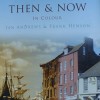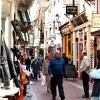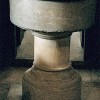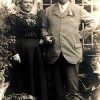Just two months before he died Harry Pouncy visited Pokesdown Technical School in Bournemouth to do what he had become accomplished at doing as an erudite hobby throughout his life: to present a lecture with slides on the beloved county of his birth. Of that lecture on February 3rd 1925 the Bournemouth Echo reported: “There is no one who can talk and bring visions of the leafy lanes of Dorset, charging the air with the scent of its fields and with the atmosphere of its stately ruins and its humble cottage homes like Mr Harry Pouncy of Dorchester.”
Pouncy’s love affair with all things Dorset and Dorset’s people showed itself early. And it cannot wholly be a coincidence that he shared his name and preoccupation with pictorialising Dorset with his contemporaries John and Walter Pouncy, who ran a notable photographic business in Dorchester. Yet their existed no direct blood-tie between himself and the father and son.
However, Pouncy is an unusual name, so it is likely that Harry was descended from a different branch of the family to that of John and Walter, though quite possibly from common ancestors. He was born near St. Peter’s Church in Dorchester and baptised there on December 8th 1870, the son of Thomas Crook Pouncy and his wife Ellen. He had two brothers; Thomas and George Ernest; and two sisters, Mabel Ellen and Michelle Ellen. His paternal grandfather was Thomas Smith Pouncy who married Sarah Crook. Their children, apart from Harry’s father, were Ann, George, Elizabeth and Marianne. Harry was the third (middle) child of Thomas and Ellen.
Growing up within easy reach of the sparsely populated Dorset countryside, Harry grew to love its very soil and acquired an enormous knowledge of the country people’s customs and folklore. He earned a reputation for being a likeable man in every respect. Not surprisingly, his later course as a public speaker and publicist for the delights of his county came to the attention of Thomas Hardy, who became one of Pouncy’s closest friends. The two would meet frequently at Maxgate, Hardy’s home, to exchange information and opinions on the countryside and its customs.
Harry Pouncy began his working life earning his living as a journalist, first as a reporter and then as proprietor of the Dorset County Chronicle and Southern Times, apart from a period serving in the First Volunteer Battalion, the Dorset Regiment during the First World War. In his senior position over more junior reporters he knew the value of a compliment towards them whilst being careful not to flatter insincerely. If a piece of writing from a junior reporter pleased him he would lavish praise unstintingly, and his words of encouragement would have a stimulating effect on his colleagues. On the other hand, slovenliness, bad spelling, wrong initialling and slipshod paragraph writing was anathema to him.
On the 7th of July 1898, when he was 28, Pouncy married Daisy Francis Anwell, a 19-year-old Dorchester spinster, at St. Peter’s Church, near to where he was living. The ceremony was witnessed by the bride’s father, John Alfred Anwell, and Harry’s brother and sister Ernest and Mabel. The Pouncy’s had a son, Harry Anwell Pouncy, born in 1899 and baptised in Dorchester that December. In the 1901 census Harry senior is recorded as a newspaper reporter, aged 31, living with Daisy, young Harry and Lionel Anwell, a relation of Daisy’s, at 41 Culliford Road, Dorchester. As a husband and father Pouncy was a good, kind, patient and conscientious man, and said to be the wisest of counsellors.
Later Pouncy resigned his career in journalism upon being appointed Secretary of the Dorset Farmers Union, his labours for which earned him the respect and friendship of every farmer in the county. Said one leading farmer to a reporter from the Echo: “They thought the world of him. He did excellent work for the organisation and more than that he helped the farmers individually with advice upon questions that perplexed them. He won all our hearts by his zeal and his loyalty and his charming modesty.”
While continuing in the service of the Farmers Union Pouncy acquired a lantern projector and began collecting slides with the intention of sharing his prodigious knowledge of Dorset with the local societies and general public through the medium of public lecturing. Given a lantern picture of a yokel Pouncy had a gift for seeming to make the bumpkin portrayed come alive. He knew the dweller of the open country as no others did.
His lectures included a series called “Old Dorset Rustic Wit & Humour” and it was said that no man was more competent or entertaining in the matter of presenting talks on and about Dorset. Nor was his subject matter limited to customs and folklore, for he could discourse equally knowledgeably on such topics as dialects, archaeology and literature, even singing traditional folk songs. A man of varied interests, Harry was for many years an active member of the Dorset Field Club and Dorchester Debating and Dramatic Society as well as a frequent and much welcomed guest speaker at meetings of the Society of Dorset Men in London.
Sadly, in his last year Pouncy’s health broke down, though even then he would not relinquish his duties with the Farmers Union until that organisation compelled him to. He had been a glutton for work all his life, frequently burning oil far into the night, a regimen that may well have prematurely ruined his health and foreshortened his life. The Farmers Union even raised the money to enable Pouncy to a take a convalescent holiday abroad. But the medical restrictions he was under prevented him from enjoying his holiday to the full as he would have liked.
The summer before he died Pouncy talked with a journalist friend in the Bournemouth pleasure gardens, remarking with some irony that it was “the first time in his life that he had the full freedom to enjoy a sort of unlimited holiday.” Like many cerebral men he wrestled with doubts and difficulties over religious faith, though he was ever open to conviction. Once he saw something to be true he cordially embraced it and acted up to his convictions.
Harry Pouncy died in Weymouth on April 28th 1925 after several weeks of illness and was buried in Dorchester cemetery close to that other great writer and surgeon Sir Frederick Treves, who had himself been baptised at the same font in St. Peters and had been born almost next door to the Cornhill house in which Pouncy was born. His funeral was attended by a huge section of the agricultural community, as well as many literary figures. As that same interviewee farmer in the Echo said: “His death was the biggest blow that could have been dealt us.”
Footnote:
From the Kingston Parish Magazine for January 1914
Entertainment
On Friday, January 23rd, in the Schoolroom, Mr. Harry Pouncy, the Dorset lecturer and entertainer, will give a popular entertainment in the Dorset dialect, comprising a recital from the poems of William Barnes, sketches from the works of Mr. Thomas Hardy (by the author’s special permission), and old Dorset songs and stories. The time will be as usual, namely, doors open at 7, commence at 7.30. Admission: First three rows 1s. ; rest of room, 6d. ; and children of school age in the Class room, 3d.The general Choir Practice in that week would be held on Thursday evening.



